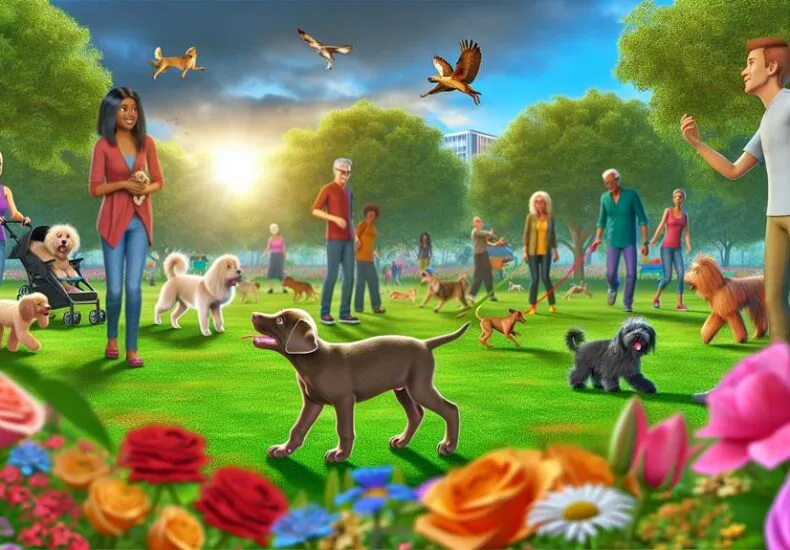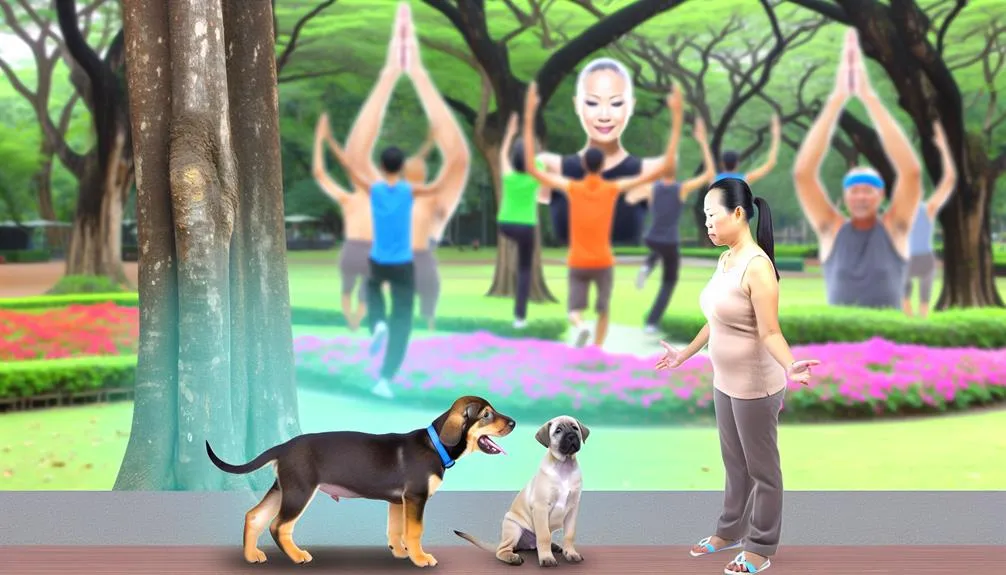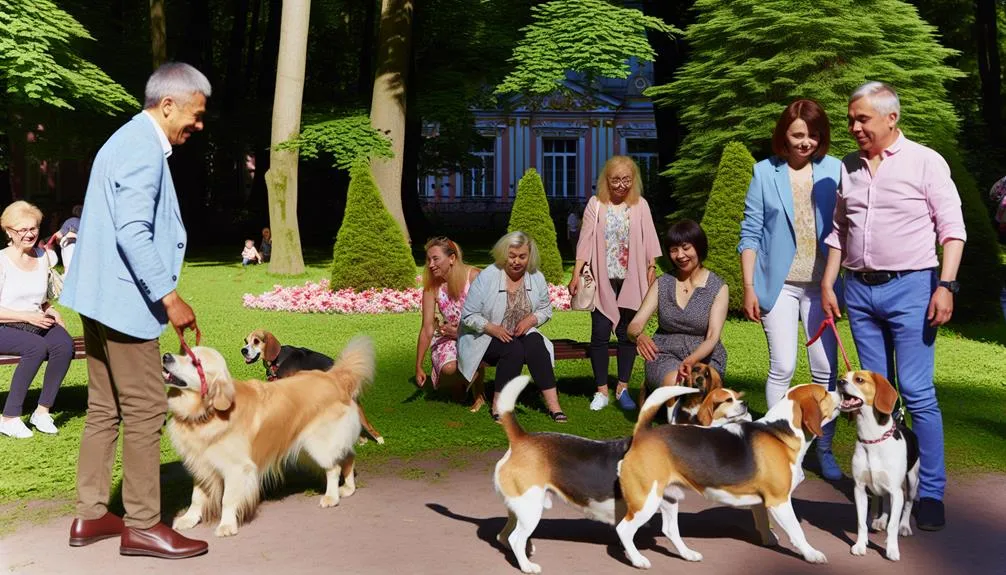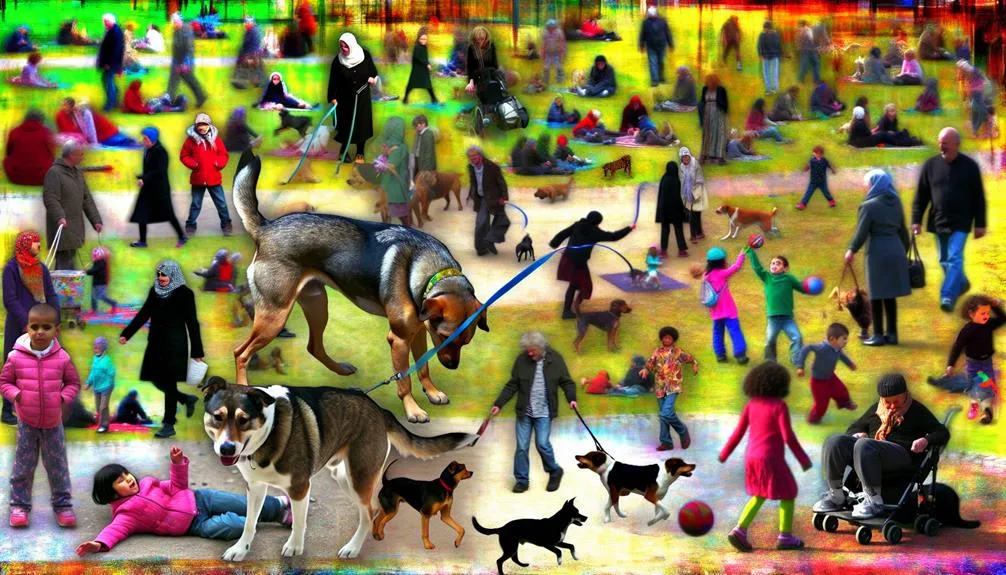
How to Socialize a Dog
When it comes to helping your dog make friends, think of it as opening a door to new experiences rather than just a chore. Socializing your dog is essential for their well-being and can set the foundation for a confident companion. You might be wondering where to start or how to navigate the complexities of canine interactions. From initial introductions to managing their reactions, there are several key strategies that can make all the difference in fostering a well-adjusted pet. Understanding these techniques could transform your approach to dog companionship.
Understanding Dog Socialization
Understanding dog socialization is essential for every pet owner who wants their furry friend to thrive in various environments. Socialization helps your dog learn appropriate dog behavior and how to interpret social cues from other dogs and people. The earlier you introduce your dog to different situations, the better they'll adapt and respond positively as they grow.
When socializing your dog, it's important to expose them to a variety of experiences, sounds, sights, and smells. This exposure helps them build confidence and reduces the chances of fear-based reactions later on. Remember, each dog has their unique personality, so take the time to observe how your furry friend reacts to new encounters. Look for signs of stress, such as excessive barking or cowering, and know when to give them space.
Encouraging positive interactions is key. Use treats or praise to reinforce good behavior when your dog successfully navigates a new situation or interacts calmly with another dog. This creates positive associations and helps them learn how to read social cues effectively.
Additionally, consider enrolling your dog in training classes or playgroups. These environments offer controlled settings where your dog can practice their social skills with guidance. Be patient and consistent; socialization is an ongoing process, not a one-time event. With your support and encouragement, your dog can grow into a well-adjusted companion who enjoys being around others, making every outing a joyful experience for both of you.
Starting Early With Puppies
Starting early with your puppy is essential for their social development. By exposing them to various environments, people, and other animals in a safe way, you'll help them grow into a well-adjusted adult dog. Focus on positive experiences to make socialization a fun and rewarding part of their early life.
Importance of Early Exposure
Early exposure to different environments, people, and other animals is essential for your puppy's development. During the critical periods of their life, the experiences they have can markedly shape their emotional development. By starting early, you're setting the foundation for a well-adjusted adult dog.
Here are four key areas to focus on when socializing your puppy:
- Diverse Environments: Take your puppy to various locations—parks, busy streets, and pet-friendly stores. Different sights and sounds will help them adapt.
- Meeting People: Introduce your puppy to a range of individuals, including children, seniors, and people of different ethnicities. This exposure fosters positive interactions.
- Interaction with Other Dogs: Arrange playdates with vaccinated and friendly dogs. This helps your puppy learn canine body language and social cues.
- Handling and Touch: Get your puppy used to being touched in various ways. Gently handle their paws, ears, and mouth to make sure they're comfortable with grooming and vet visits.
Safe Socialization Practices
How can you guarantee your puppy has a positive socialization experience? Start by exposing them to a variety of controlled environments. Dog parks can be overwhelming for young pups, so consider scheduling supervised interactions with well-behaved dogs during play dates. This allows your puppy to learn social cues in a safe setting.
Enrolling your puppy in training classes is another effective way to promote fear reduction and teach essential skills. These classes provide structured environments where your pup can meet other dogs and people while focusing on commands. Group walks can also be beneficial, allowing your puppy to experience different sights, sounds, and smells while under your guidance.
Incorporate enrichment activities to keep your puppy engaged and help develop their confidence. Behavioral assessments can assist in identifying your pup's comfort level with various situations, guaranteeing you progress at a pace that suits them. Always prioritize safety and guarantee interactions are supervised, so your puppy feels secure during their socialization journey.
Gradual Exposure Techniques

Building confidence in your dog through gradual exposure techniques can be a rewarding experience for both of you. This approach helps reduce fear responses by slowly introducing your dog to new situations, people, or environments. By observing your dog's body language, you can tailor the exposure to guarantee it's comfortable and manageable.
Here's a simple guide to implementing gradual exposure techniques:
- Identify Triggers: Determine what specifically causes your dog to feel anxious or fearful. It could be loud noises, other animals, or unfamiliar people.
- Start Small: Begin with low-intensity exposure. For instance, if your dog is scared of other dogs, start by observing them from a distance where your dog feels safe.
- Increase Exposure Gradually: As your dog becomes more comfortable, slowly decrease the distance or increase the intensity of the exposure. Pay close attention to their body language; signs of stress may include tucked tails, raised hackles, or excessive barking.
- Monitor and Adjust: Keep track of your dog's reactions and adjust the exposure levels accordingly. If your dog shows signs of distress, take a step back and give them space to regroup.
Positive Reinforcement Methods
Positive reinforcement is a powerful tool in socializing your dog, as it encourages good behavior through rewards. Using treats and toys can make training fun and engaging for your pup, while consistency and patience are key to reinforcing those positive habits. By focusing on rewarding the behaviors you want to see, you'll help your dog feel more confident and social in various situations.
Rewarding Good Behavior
Rewarding good behavior is a cornerstone of effective dog socialization, and it can transform your pup into a well-mannered companion. By understanding social cues and your dog's body language, you can create a positive environment for learning. Here are some practical ways to implement positive reinforcement:
- Verbal Praise: Use a cheerful tone to let your dog know they've done well. This reinforces their understanding of acceptable behavior.
- Physical Affection: A gentle pat or scratch behind the ears can reinforce your pup's good behavior, making them feel loved and appreciated.
- Playtime: Engaging in a fun game after your dog displays good behavior can help solidify their understanding of socially appropriate actions.
- Consistent Commands: Use the same verbal cues for specific behaviors. Consistency helps your dog pick up on what you expect from them.
Treats and Toys
Many dog owners find that incorporating treats and toys into their training routine can enhance the effectiveness of socialization. The right treat selection and timing can motivate your dog to engage positively with new experiences. Opt for a variety of treats—like chew treats and small, soft rewards—so your dog stays interested.
When it comes to toys, consider the types that promote interaction and engagement. Interactive toys keep your dog mentally stimulated during play sessions, while durable toys can withstand enthusiastic chewing, ensuring they last longer.
Here's a quick reference table to help you choose the best treats and toys:
| Treats | Toys |
|---|---|
| Chew treats | Interactive toys |
| Soft training treats | Durable chew toys |
| Variety of flavors | Squeaky toys |
Consistency and Patience
Establishing consistency and patience in your dog's socialization process is essential for long-term success. When you're consistent in your approach, your dog can learn to understand behavioral cues in various social settings. This helps reduce anxiety and builds confidence. Here are four key strategies to keep in mind:
- Routine: Create a regular schedule for socialization sessions. Frequent exposure to new environments helps your dog adapt better over time.
- Positive Reinforcement: Use treats and praise to reward your dog for displaying desirable behaviors in social situations. This encourages them to repeat those behaviors.
- Environment Control: Start in low-distraction environments before gradually introducing more challenging social settings. This allows your dog to focus on you and learn at their own pace.
- Patience: Understand that every dog learns differently. Some may take longer to adjust than others. Celebrate small victories and remain calm during setbacks.
Socializing With Other Dogs

Socializing your dog with other dogs is essential for their development and overall happiness. It helps them learn important social cues and behaviors, making them more well-adjusted and confident. One of the best ways to start this process is by arranging play dates with friendly and vaccinated dogs. This controlled environment allows your dog to interact with others, building their social skills and helping them learn how to engage in play without becoming overwhelmed.
Dog parks are another fantastic option for socialization. These spaces provide ample opportunities for dogs to meet and interact with a variety of breeds and personalities. When visiting a dog park, keep a close eye on your dog's body language and interactions. If they seem uncomfortable or overly aggressive, it might be best to step back and give them some space. Remember, not all dogs are compatible, and it's okay to remove your dog from the situation if things aren't going well.
Start with short visits and gradually increase the time spent at the park as your dog becomes more comfortable. Make sure to reward positive behavior with treats and praise, reinforcing their good interactions. This way, they'll associate socializing with a positive experience. With time and patience, your dog will learn how to navigate their interactions with other dogs, leading to a happier and more sociable companion.
Meeting New People
Introducing your dog to new people is just as important as their interactions with other dogs. Positive experiences with new person interactions can help your dog become well-adjusted and confident. To guarantee successful introductions, observe your dog's body language and follow these practical steps:
- Start Slow: Begin by introducing your dog to calm, dog-friendly individuals. This helps create a comfortable environment for both your dog and the new person.
- Observe Body Language: Pay attention to your dog's body language. Signs of stress, like tail tucking or excessive yawning, indicate your dog may need more space. If they seem relaxed, encourage interaction.
- Use Treats: Reward your dog with treats during new person interactions. This creates a positive association, making them more open to meeting new people in the future.
- Encourage Positive Greetings: Teach your dog to greet new people politely. Use commands like "sit" or "stay" to help manage their excitement, reinforcing good behavior.
Handling Unfamiliar Environments

Steering through unfamiliar environments can be a bit overwhelming for both you and your dog, but with a little preparation, it can also be an exciting adventure. To help your dog adapt, start by gradually introducing them to urban environments. Take short walks in busy areas, allowing them to experience the hustle and bustle without feeling overwhelmed.
When exploring outdoor adventures, consider varying your routes. This exposes your dog to diverse surfaces, like grass, gravel, and pavement, which can help them adjust to different textures under their paws. Pay attention to changing scenery; each park or street will present new sights and smells, stimulating their curiosity.
Crowded spaces can be particularly challenging. Begin with less populated areas and slowly work your way up to busier locations. This gradual exposure helps your dog build confidence while encountering new sounds and unfamiliar animals. If your dog seems anxious, give them space and time to observe rather than forcing interaction.
During travel experiences, make sure your dog feels secure in the car or on public transport. Bring along familiar items, like their favorite blanket or toy, to create a sense of comfort. As you navigate various environments, remember to reward your dog with treats and praise for calm behavior.
Frequently Asked Questions
What Are the Signs of a Well-Socialized Dog?
A well-socialized dog shows positive behaviors like relaxed body language, wagging tails, and friendly interactions. They read social cues effectively, remaining calm around new people and pets, making outings enjoyable and stress-free for both of you.
Can Older Dogs Be Socialized Effectively?
Older dogs can be socialized effectively with the right techniques. You'll see incredible benefits, like improved confidence and reduced anxiety. Patience and small steps are key—embrace the journey, and watch your dog thrive!
How Do I Handle My Dog's Fear of Loud Noises?
If your dog's fearful of loud noises, try desensitization techniques by gradually exposing them to the sounds at a low volume. Combine this with positive reinforcement, rewarding calm behavior to build their confidence over time.
What Should I Do if My Dog Shows Aggression?
When your dog's like a volcano ready to erupt, recognizing Aggression triggers is key. Use positive reinforcement to redirect their energy, rewarding calm behavior. Gradually expose them to triggers, fostering trust and reducing their stress.
Are There Specific Breeds More Challenging to Socialize?
Yes, some breeds have temperaments that make socialization more challenging. Understanding each breed's unique traits helps you navigate socialization stages effectively. With patience and consistent effort, you can help any dog thrive socially.
Conclusion
Socializing your dog is like planting a seed; with the right care, it'll blossom into a well-adjusted companion. Remember, consistency and patience are key. By exposing your dog to new experiences, people, and environments, you're building their confidence and helping them thrive. Keep using positive reinforcement, and don't rush the process. With time and effort, you'll nurture a happy, sociable dog ready to take on the world with you by their side.
You may also like
Archives
Calendar
| M | T | W | T | F | S | S |
|---|---|---|---|---|---|---|
| 1 | 2 | 3 | 4 | 5 | 6 | |
| 7 | 8 | 9 | 10 | 11 | 12 | 13 |
| 14 | 15 | 16 | 17 | 18 | 19 | 20 |
| 21 | 22 | 23 | 24 | 25 | 26 | 27 |
| 28 | 29 | 30 | ||||
Leave a Reply